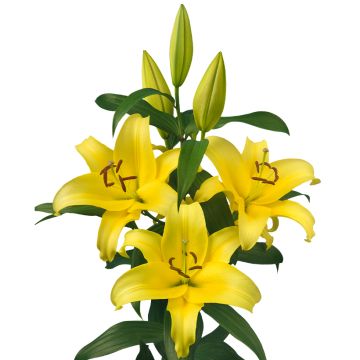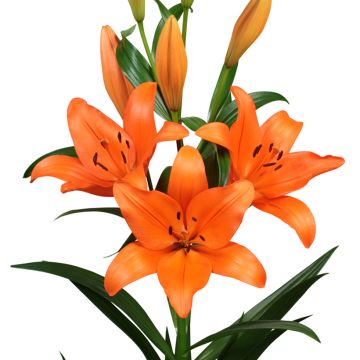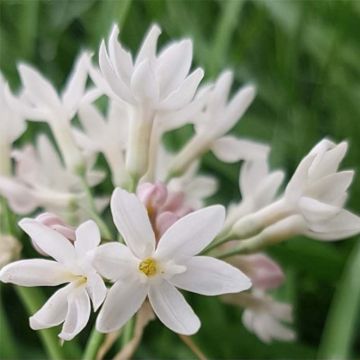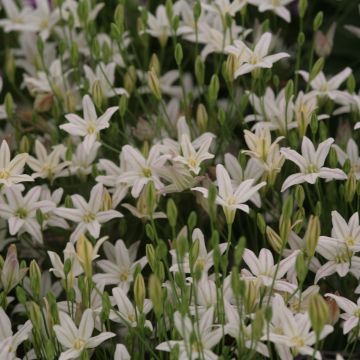

Lilium Asiatic mix
Lilium Asiatic mix
Lilium x asiatica Mix
Asiatic Lily
Beautiful, I had chosen them for cutting flowers but seeing their beauty, I preferred to enjoy them in the garden. The flowering period was very long.
VIVIANE C, 20/10/2024
This plant carries a 6 months recovery warranty
More information
We guarantee the quality of our plants for a full growing cycle, and will replace at our expense any plant that fails to recover under normal climatic and planting conditions.
From €5.90 for pickup delivery and €6.90 for home delivery
Express home delivery from €8.90.

Does this plant fit my garden?
Set up your Plantfit profile →
Description
This assortment of Asitic lilies is a mix of 6 bulbs, varying depending on the batches, in a blend of orange, red, pink, and yellow. These long-lasting bulbs are easy to grow in light, non-chalky soil. Once well established, they faithfully bloom every summer, adding a touch of exoticism and colour to flower beds, pots, or even large rockeries. Elegant and graceful Asiatic lilies make excellent cut flowers.
The genus Lilium belongs to the lily family, its representatives are deciduous bulbs, with a narrow and very vertical tufted habit from spring onwards. They descend from various species native to Asia Minor and Central Asia. Each batch includes 6 lily bulbs among the following varieties: bright orange single flowers, orange single flowers, red single flowers with yellow hearts, yellow single flowers, dark red single flowers, bright pink single flowers, golden yellow single flowers, and double and fringed lemon yellow flowers. Each plant is 70 to 80 cm high when in bloom, and the clump spreads indefinitely over time, with the bulbs producing bulblets through vegetative multiplication. Flowering takes place between late June and August. Along the sturdy stems, 5 to 8 flowers measuring on average 10 cm in diameter open on a mature plant. Each flower is composed of 6 fleshy, shiny-textured petals, with variable colours depending on the varieties. The stems are sturdy and covered with alternate, dark green, narrow, and shiny leaves. The above-ground vegetation dries up and disappears in late autumn, while the bulb enters a dormant state.
These Asiatic lilies thrive year after year in neutral, humus-bearing, well-drained, and light soil that remains moist in summer. You can grow them with perennial plants, as they appreciate having their base slightly shaded. Lilies go well with daylilies, bellflowers, delphiniums, alstroemerias... They are perfect for flower beds, thrive in large borders, and pots, and are good cut flowers.
Report an error about the product description
Plant habit
Flowering
Foliage
Botanical data
Lilium
x asiatica
Mix
Liliaceae
Asiatic Lily
Cultivar or hybrid
Other Lilies A to Z
Planting and care
The Asiatic lily appreciates humus-bearing, neutral to slightly acidic, well-drained and light soils, remaining slightly moist in summer. Plant it in full sun, with the feet in the shade, preferably in spring, planting the bulbs 15 cm deep in a pocket of soil mixed with leaf compost. Surround them with a pocket of sand that will prevent rot and attacks from slugs, while allowing them to grow more easily. Mark the planting location, as vegetation only starts in April. If red lily beetles appear, treat them immediately, as their larvae can devour all the leaves. The most effective method is to catch them manually but be careful, they drop as soon as you touch them.
After flowering, it is a good idea to cut the faded flowers halfway to keep the bed beautiful during the summer.
Tips for planting lilies in compact soil: Lily bulbs dislike clay soils that suffocate them and cause rot. In Eastern Europe, the following technique is used to help these bulbs survive the winter. Plant them on 'benches' built above ground level. These benches consist of a layer of gravel, on which tightly packed branches are placed. Then cover everything with a thick layer of compost 20 to 30 cm deep. Plant the bulbs in the compost, on which you can also let some ground-covering plants crawl.
On the terrace, you can create sumptuous pots with lilies. Choose a container that is large and deep enough (at least 16 cm in diameter for 1 bulb). Fill it with a mixture of garden soil, leaf compost, and sand. Plant the lilies in groups of 3 to 5 bulbs, 10-15 cm apart, then water abundantly. Place the pots in a cool room or outside once all risk of frost has passed. The ambient temperature should be around 12°C. When the shoots appear, place the pot in a conservatory or a very bright room, at a temperature of around 18°C. Apply liquid fertiliser twice a month until the flower buds appear.
Planting period
Intended location
Care
-
, onOrder confirmed
Reply from on Promesse de fleurs
Hardy summer bulbs
Haven't found what you were looking for?
Hardiness is the lowest winter temperature a plant can endure without suffering serious damage or even dying. However, hardiness is affected by location (a sheltered area, such as a patio), protection (winter cover) and soil type (hardiness is improved by well-drained soil).

Photo Sharing Terms & Conditions
In order to encourage gardeners to interact and share their experiences, Promesse de fleurs offers various media enabling content to be uploaded onto its Site - in particular via the ‘Photo sharing’ module.
The User agrees to refrain from:
- Posting any content that is illegal, prejudicial, insulting, racist, inciteful to hatred, revisionist, contrary to public decency, that infringes on privacy or on the privacy rights of third parties, in particular the publicity rights of persons and goods, intellectual property rights, or the right to privacy.
- Submitting content on behalf of a third party;
- Impersonate the identity of a third party and/or publish any personal information about a third party;
In general, the User undertakes to refrain from any unethical behaviour.
All Content (in particular text, comments, files, images, photos, videos, creative works, etc.), which may be subject to property or intellectual property rights, image or other private rights, shall remain the property of the User, subject to the limited rights granted by the terms of the licence granted by Promesse de fleurs as stated below. Users are at liberty to publish or not to publish such Content on the Site, notably via the ‘Photo Sharing’ facility, and accept that this Content shall be made public and freely accessible, notably on the Internet.
Users further acknowledge, undertake to have ,and guarantee that they hold all necessary rights and permissions to publish such material on the Site, in particular with regard to the legislation in force pertaining to any privacy, property, intellectual property, image, or contractual rights, or rights of any other nature. By publishing such Content on the Site, Users acknowledge accepting full liability as publishers of the Content within the meaning of the law, and grant Promesse de fleurs, free of charge, an inclusive, worldwide licence for the said Content for the entire duration of its publication, including all reproduction, representation, up/downloading, displaying, performing, transmission, and storage rights.
Users also grant permission for their name to be linked to the Content and accept that this link may not always be made available.
By engaging in posting material, Users consent to their Content becoming automatically accessible on the Internet, in particular on other sites and/or blogs and/or web pages of the Promesse de fleurs site, including in particular social pages and the Promesse de fleurs catalogue.
Users may secure the removal of entrusted content free of charge by issuing a simple request via our contact form.
The flowering period indicated on our website applies to countries and regions located in USDA zone 8 (France, the United Kingdom, Ireland, the Netherlands, etc.)
It will vary according to where you live:
- In zones 9 to 10 (Italy, Spain, Greece, etc.), flowering will occur about 2 to 4 weeks earlier.
- In zones 6 to 7 (Germany, Poland, Slovenia, and lower mountainous regions), flowering will be delayed by 2 to 3 weeks.
- In zone 5 (Central Europe, Scandinavia), blooming will be delayed by 3 to 5 weeks.
In temperate climates, pruning of spring-flowering shrubs (forsythia, spireas, etc.) should be done just after flowering.
Pruning of summer-flowering shrubs (Indian Lilac, Perovskia, etc.) can be done in winter or spring.
In cold regions as well as with frost-sensitive plants, avoid pruning too early when severe frosts may still occur.
The planting period indicated on our website applies to countries and regions located in USDA zone 8 (France, United Kingdom, Ireland, Netherlands).
It will vary according to where you live:
- In Mediterranean zones (Marseille, Madrid, Milan, etc.), autumn and winter are the best planting periods.
- In continental zones (Strasbourg, Munich, Vienna, etc.), delay planting by 2 to 3 weeks in spring and bring it forward by 2 to 4 weeks in autumn.
- In mountainous regions (the Alps, Pyrenees, Carpathians, etc.), it is best to plant in late spring (May-June) or late summer (August-September).
The harvesting period indicated on our website applies to countries and regions in USDA zone 8 (France, England, Ireland, the Netherlands).
In colder areas (Scandinavia, Poland, Austria...) fruit and vegetable harvests are likely to be delayed by 3-4 weeks.
In warmer areas (Italy, Spain, Greece, etc.), harvesting will probably take place earlier, depending on weather conditions.
The sowing periods indicated on our website apply to countries and regions within USDA Zone 8 (France, UK, Ireland, Netherlands).
In colder areas (Scandinavia, Poland, Austria...), delay any outdoor sowing by 3-4 weeks, or sow under glass.
In warmer climes (Italy, Spain, Greece, etc.), bring outdoor sowing forward by a few weeks.






















































